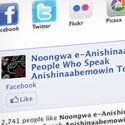There was a time when everyone living in Michigan grew up speaking the native language of the area’s indigenous people. Now fewer than 10 people born in the state are fluent, yet more than 2,700 people “like” the language on Facebook.
Howard Kimewon, who teaches in the University of Michigan’s Ojibwe Language program, part of the College of Literature, Science, and the Arts Program in American Culture, was born in Ontario and grew up speaking the language there. His colleague Margaret Noori learned the language later in life in Minnesota, where she grew up. And now she is combining her background in linguistics and marketing with a facility for social media and technology to leverage interest in the language she has come to love.
“I want to use every available platform to its utmost,” said Noori, director of the U-M Comprehensive Studies Program and a lecturer in the Ojibwe language and literature.
Noori made a presentation on crossing the digital divide to help save endangered and minority languages on Feb.17 at the annual meeting of the American Association for the Advancement of Science (AAAS) in Vancouver, Canada. In her talk, she explored ways that tools of modern life from Facebook and Twitter to YouTube are helping to keep the native language of the Ojibwe people—called Ashininaabemowin—alive.
“We started our website—www.ojibwe.net—in 2006,” Noori said. The goals: to produce proficiency in the next generation, and to archive the contributions of fluent elders. “We save all the posts of fluent elders, and archive them at the Bentley, adding to the storehouse of information about this endangered language.”
The website now contains more than 450 audio files, in addition to lessons, songs, and stories. During 2011, more than 9,000 people made 16,519 visits to the website, according to Noori. The site contains a series of spoken lessons and examples of the language, aimed at people who are auditory and visual learners. And the social media sites are all accessible from the website, to encourage feedback and help connect visitors to each other.
According to Noori, about 400 people in Michigan now use the language, but about 80 percent of Anishinaabemowin speakers are over the age of 65. She estimates the total number of speakers, including those from other states and from Canada, at about 15,000 or less.
This language is one of about 27 Algonquian languages spoken in and around the Great Lakes. At one point, more than 200 reservations, or reserves—as they’re called in Canada—would have used Anishinaabemowin as their home language.




Joan Kripke - 1973, 1986
I find it ironic that in an article about language,the first paragraph incorrectly states that, “less that 10 people born in the state are fluent” in an indigenous language. “Fewer” than 10 people, please.
Reply
Deborah Holdship
Fixed. Thanks for pointing out the error. Anne Curzan has a column on this very topic, “Less vs. fewer” in the “Talking About Words” section of Michigan Today.
Reply
Susan Topol - 1979
Margaret Noori has made her Anishinaabe learning materials (http://openmi.ch/om-ojibwe) available under an open license and published for anyone to download and share from the Open.Michigan repository (http://open.umich.edu/education). In doing so, she is broadening the reach for these valuable resources, bringing them to a larger audience, and further helping to preserve this culture and language.
Reply